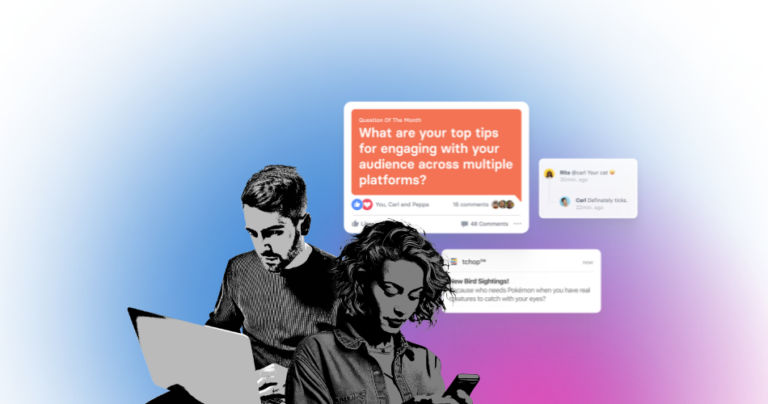Internal communication has long been viewed as a one-way broadcast system. Companies send out information, and employees are expected to consume it. While this approach may have worked in traditional corporate structures, today’s workplaces demand a more interactive, participatory model of communication. Employees expect not just to receive information but to engage with it, contribute to discussions and have their voices heard.
When we adapted the User Needs Model 2.0 (originally designed for journalism) to internal communications, we realised that something essential was missing: engagement as a core function of workplace communication.
The User Needs Model 2.0 already included “Keep me engaged” under Fact-driven needs, an evolution of “Keep me on trend” from earlier versions of the model. However, this framing was still rooted in content consumption rather than active participation. Engagement in media is about retaining audience interest, but in internal communications, it is about facilitating dialogue and ensuring employees are integral to the communication process.
Recognising this distinction, we introduced “Engage me” as a new core dimension, rather than simply adapting “Keep me engaged” from the journalism model.
How engagement differs in journalism vs. internal communications
To understand why engagement required a dedicated dimension in internal communications, it is important to distinguish how engagement functions in journalism versus the workplace.
| In journalism (User Needs Model 2.0) | In internal communications (User Needs Model for IC) |
|---|---|
| Engagement ensures audiences stay interested and involved with ongoing discussions, trends and news cycles. | Engagement ensures employees feel heard, valued and included in shaping workplace culture and communication. |
| Readers engage by consuming, sharing and discussing content, but they remain external to the editorial process. | Employees engage by participating, providing feedback, contributing to discussions and influencing organizational decisions. |
| “Keep me engaged” encourages audiences to stay informed and follow updates. | “Engage me” ensures employees can actively shape the communication process rather than just receive updates. |
The fundamental difference is clear:
- Journalism engagement is about interaction with content.
- Internal comms engagement is about interaction with the organization itself.
This shift is why engagement could not simply remain a subcategory. It needed to be elevated into a core function of workplace communication.

Why “Keep me engaged” wasn’t enough
In User Needs Model 2.0, engagement was categorized under fact-driven communication as “Keep me engaged.” This dimension ensured that audiences remained connected to ongoing stories and discussions, keeping them interested and informed.
However, if we had simply retained “Keep me engaged” as a subcategory in our internal communications model, it would have failed to capture the full scope of what engagement means in a corporate environment.
Employees are not just passive recipients of information, they are active stakeholders whose input, feedback and participation shape the company itself. A fact-driven engagement model, as seen in media, would have reduced engagement to simply keeping employees updated rather than ensuring they have a voice, contribute to discussions and play an active role in shaping company culture.
This is why “Engage me” had to be a standalone core dimension.
What “Engage me” adds to internal communications
By introducing “Engage me,” we acknowledged that effective internal communication requires more than just delivering information. It requires active participation from employees.
1. Two-way communication instead of one-way messaging
Traditional internal communications often focus on informing employees, but rarely on involving them. Many organizations still rely on top-down messaging, where leadership sends updates and employees are expected to consume them without question.
“Engage me” ensures that communication is:
- Interactive: Employees can ask questions, contribute ideas and be part of the conversation.
- Responsive: Organizations actively listen to employee feedback and take action.
- Inclusive: All employees, regardless of role or level, have opportunities to participate in discussions.
This is fundamentally different from engagement in media, where audiences may respond to content, but do not influence editorial decisions. In the workplace, employees must be able to shape communication itself.
2. Feedback loops and participation mechanisms
One of the most common challenges in corporate environments is the lack of transparent feedback mechanisms. Many employees feel that internal communication exists to inform them, not to engage them.
“Engage me” addresses this by prioritizing:
- Employee feedback channels such as pulse surveys, open forums and town hall discussions.
- Opportunities for employees to challenge decisions and offer alternative perspectives.
- Recognition of employee contributions, ensuring they see tangible outcomes from their feedback.
This differs significantly from audience engagement in media, where readers can share opinions but rarely influence newsroom operations. In contrast, employees have a direct stake in shaping their organization.
3. Moving beyond information consumption to active involvement
Many organizations believe that keeping employees informed automatically leads to engagement, but this is not the case.
For example, an internal newsletter announcing a major policy change may keep employees informed, but it does not guarantee they feel engaged with or connected to that change.
“Engage me” shifts the focus from:
- Passive communication → To active involvement.
- One-way updates → To open dialogue.
- Simply delivering information → To encouraging participation.
In essence, “Engage me” ensures that employees are not just aware of workplace initiatives, but that they have a role in shaping them.

What happens when engagement is ignored?
Organizations that fail to prioritize employee engagement in internal communications risk:
- Low morale and disengagement: Employees feel disconnected from leadership and company culture.
- Lack of trust and transparency: Employees may feel that their voices are not valued or considered.
- Reduced retention and productivity: Employees who do not feel heard are more likely to disengage or leave.
Without “Engage me,” internal communication risks becoming a one-way information dump. Where updates are delivered, but no real connection or participation is fostered.
The impact of “Engage me” on internal communications
By making “Engage me” a core dimension, internal communications becomes:
- More participatory: Employees contribute rather than just consume.
- More meaningful: Employees feel valued and included in the process.
- More effective: Engagement leads to higher retention, productivity and alignment with company goals.
This ensures that internal communication is not just about what leadership says, but about how employees contribute to shaping the organization.
Takeaway
The decision to add “Engage me” was not just about redefining engagement, it was about redefining internal communication itself.
In journalism, engagement is about keeping audiences interested in content. In internal comms, engagement is about ensuring employees feel connected, heard and empowered to shape their workplace.
By elevating “Engage me” as a core dimension, we recognize that:
- Communication is incomplete unless employees can participate in the conversation.
- Engagement is not just about keeping employees informed. It is about making them feel heard.
- A company’s internal communications strategy is only as strong as the level of participation it enables.
This is why “Engage me” is not simply a reframed “Keep me engaged” from journalism. It is an essential pillar of a modern, dynamic internal communications model.
Organizations that understand this will not just inform employees, they will empower them to shape the future of work.








